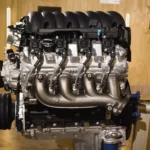If your Mazda’s engine is making unusual noises, burning oil, or showing warning lights, you’re likely facing one of the many engine problems that can affect these otherwise reliable vehicles. While Mazdas are known for their driving dynamics and value, certain engine issues have plagued specific models and generations.
Let’s explore the most common Mazda engine problems, how to identify them early, and what you can do to extend your engine’s life.
The Most Common Mazda Engine Problems
Mazda engines have earned a generally positive reputation for reliability, but several recurring issues have emerged across various models. Understanding these problems can help you spot early warning signs and avoid costly repairs.
Coolant Leaks in SKYACTIV-G 2.5T Engines
The SKYACTIV-G 2.5T turbocharged engines in 2018-2021 Mazda6, 2016-2023 CX-9, and 2019-2024 CX-5 models have become notorious for coolant leaks. These problems stem from a structural weakness in the cylinder head near the exhaust manifold.
When coolant seeps into the combustion chamber, it mixes with engine oil, reducing lubrication and potentially causing:
- Engine overheating
- Piston ring damage
- White exhaust smoke
- Complete engine failure
Many owners have reported repair costs exceeding $6,000 for engine replacements, with some vehicles experiencing repeated failures even after repairs. A class action lawsuit alleges that Mazda knew about this defect but failed to properly address it.
Variable Valve Timing (VVT) System Failures
Older Mazda models with L-series engines (particularly 2007-2012 CX-7 and 2004-2008 Mazda6) frequently suffer from problems with their variable valve timing systems. The main issues include:
- Defective VVT solenoids
- Failing timing chain tensioners
- Oil leaks
- Excessive exhaust smoke
- Timing chain stretch
When the timing chain stretches and jumps timing, it can cause valve-piston interference, resulting in catastrophic engine damage. While Mazda extended warranties for certain models to 7 years/100,000 miles, many owners have reported failures beyond this coverage period, leading to repairs costing $2,000-$4,000.
The technical analysis of these engines shows that the lack of keyed crankshafts and camshafts makes timing adjustments complicated, increasing the risk of improper repairs.
Cylinder Head Cracks in Naturally Aspirated 2.5L Engines
Owners of 2018-2023 CX-5 and CX-9 models have reported cracks developing in the cylinder head, typically resulting in oil or coolant leaks. These issues often appear around the 50,000-mile mark and can cost over $6,600 to repair when a complete head replacement is needed.
According to discussions among Mazda owners, Mazda has acknowledged these issues through technical service bulletins but has not issued a full recall, often categorizing these failures as “isolated incidents.”
Oil Lubrication Problems in MZR/Duratec Engines
The MZR 2.3L turbocharged engine (shared with Ford’s Duratec) found in vehicles like the 2010 Mazda3 has shown a tendency for oil starvation issues. Engine teardowns of failed units have revealed:
- Spun rod bearings (particularly on cylinder #4)
- Insufficient oil flow
- Piston-to-valve contact
- Engine seizure
A detailed analysis attributes these failures to a combination of aggressive driving habits, oil degradation, and a flawed oil pump drive chain design.
Water Pump Failures in Cyclone Engines
The 3.5L and 3.7L Cyclone engines in 2008-2015 CX-9 and 2009-2013 Mazda6 models are prone to water pump failures. When the water pump fails, coolant can leak into the oil system, causing:
- Bearing wear
- Engine seizure
- Cooling system malfunction
- Overheating
A lawsuit against Mazda regarding these issues was dismissed, though an appeal is pending.
Early Warning Signs of Mazda Engine Problems
Identifying engine problems early can save you thousands in repair costs. Here are key warning signs to watch for in your Mazda:
Unusual Engine Noises
Listen for these sounds that may indicate engine trouble:
- Knocking or tapping sounds: Often indicates problems with rod bearings or your engine’s valve train
- Whining noises: Might signal issues with the timing chain tensioner
- Grinding sounds: Could point to serious internal engine damage
Fluid Leaks and Consumption Issues
Keep an eye out for:
- Coolant leaks: Small puddles of sweet-smelling, greenish fluid under your car
- Oil spots on your driveway: Dark stains indicating oil seal failures
- Increasing oil consumption: Having to add oil between oil changes
- White smoke from exhaust: Indicates coolant entering combustion chambers
Dashboard Warning Lights
Don’t ignore these important indicators:
- Check Engine Light: Could indicate various issues from minor sensor problems to major engine malfunctions
- Oil Pressure Warning Light: Signals dangerously low oil pressure that can cause immediate engine damage
- Temperature Warning Light: Indicates overheating that can warp cylinder heads
Performance Changes
Be alert to these changes in how your Mazda drives:
- Hesitation during acceleration
- Rough idling or stalling
- Decreased fuel economy
- Loss of power, especially under load
The Most Problematic Mazda Models and Years
While Mazda generally produces reliable vehicles, certain model years have shown more frequent engine issues than others:
| Model | Problematic Years | Common Engine Issues |
|---|---|---|
| CX-5 | 2018-2023 | Cylinder head cracks, coolant leaks in turbocharged models |
| CX-9 | 2016-2023 | SKYACTIV-G 2.5T coolant leaks, cylinder head failures |
| Mazda6 | 2018-2021 | Turbocharged engine coolant leaks, engine overheating |
| CX-7 | 2007-2012 | VVT system failures, timing chain issues |
| Mazda3 | 2010-2013 | Oil lubrication problems, especially in turbo models |
These model years have shown higher-than-average rates of engine-related complaints and warranty claims.
Software and Electrical Problems in Newer Models
The latest Mazda models face a different set of challenges related to engine management systems:
Recent Recalls in 2024-2025 Models
The 2024-2025 CX-90 and 2025 CX-70 plug-in hybrids have been subject to recalls for software defects in the Electrical Supply Unit (ESU). These issues can disable critical functions like:
- Defroster
- Seatbelt warnings
- High-voltage battery cooling during startup
A separate recall addresses faulty powertrain control module (PCM) software that may prevent engine restarts after idle stops or trigger sudden loss of drive power. According to Cars.com research, over 150,000 vehicles are affected by these recalls, with repairs requiring dealership software updates.
The NHTSA documentation confirms these software-related issues affect the newest members of Mazda’s lineup.
Preventive Maintenance to Avoid Mazda Engine Problems
Taking proactive steps can help you avoid or minimize the impact of common Mazda engine issues:
Regular Oil Changes and Fluid Checks
- Use the manufacturer-recommended oil type (usually synthetic)
- Change oil every 5,000-7,500 miles, more frequently in turbocharged models
- Check coolant levels weekly, looking for changes in color or consistency
- Inspect the coolant reservoir for any signs of oil contamination (milky appearance)
Cooling System Maintenance
For models prone to coolant leaks (especially SKYACTIV-G 2.5T engines):
- Have the cooling system pressure-tested annually
- Replace coolant according to the maintenance schedule (typically every 30,000 miles)
- Check for coolant leaks around the cylinder head and exhaust manifold
- Monitor engine temperature gauge for any unusual fluctuations
Timing Chain and VVT System Care
For L-series engines with VVT issues:
- Listen for timing chain rattle, especially during cold starts
- Have the VVT system inspected during regular service intervals
- Consider preventive replacement of timing chain components around 60,000 miles
- Use high-quality oil that meets Mazda specifications to reduce VVT wear
Addressing Software Updates
For 2024-2025 models:
- Respond promptly to recall notices
- Check with your dealer about available software updates for the engine control module
- Monitor for any unusual behavior from electronic systems
- Use the CarAndDriver recall tracker to stay informed about the latest safety updates
The Strange Case of Spider Infestations
In one of the automotive world’s more unusual problems, Mazda6 sedans have experienced issues with yellow sac spiders nesting in the evaporative emission systems. These eight-legged intruders can block vent lines, triggering:
- Check engine lights
- Fuel tank deformation
- Potential fire hazards
Mazda issued a warranty extension covering repairs, which typically involve installing a spring-loaded filter in the vent line. While this issue isn’t directly engine-related, it demonstrates how even unusual factors can affect your vehicle’s performance.
Dealing with Engine Failure: Your Options
If you’re facing a serious Mazda engine problem, you have several options:
Warranty Coverage and Recalls
- Check if your vehicle is still under the manufacturer’s warranty (typically 3 years/36,000 miles)
- Verify if extended warranty coverage applies to your specific issue
- Search the NHTSA database for recalls related to your vehicle’s make, model, and year
- Contact Mazda customer service to inquire about goodwill repairs for known issues
Repair vs. Replace
When facing major engine problems, you’ll need to decide whether to repair or replace:
- Minor issues: Replacing individual components like water pumps, timing chains, or VVT components might make economic sense
- Catastrophic failure: Complete engine replacement might be necessary for cracked cylinder heads or seized engines
- Rebuild option: Engine rebuilding offers a middle ground, typically costing 50-75% of a new engine
Finding Expert Help
Not all mechanics have experience with Mazda-specific issues. Consider:
- Mazda dealership service departments for warranty work and specialized knowledge
- Independent Mazda specialists who often offer lower labor rates than dealers
- Getting multiple opinions and quotes before proceeding with major repairs
Long-Term Engine Protection Strategies
Beyond regular maintenance, consider these approaches to extend your Mazda’s engine life:
Driving Habits That Protect Your Engine
- Allow proper warm-up time in cold weather (30-60 seconds is sufficient)
- Avoid aggressive driving, especially in turbocharged models
- Don’t lug the engine (driving at low RPM in too high a gear)
- Reduce short trips where the engine never reaches operating temperature
Aftermarket Solutions
Some owners have found success with:
- Higher-quality aftermarket timing chain components for L-series engines
- Oil catch cans to reduce carbon buildup in direct-injection engines
- Upgraded cooling system components for models prone to overheating
Understanding Mazda’s Engine Warranty Coverage
Mazda provides different warranty protection for various components:
- Basic bumper-to-bumper warranty: 3 years/36,000 miles
- Powertrain warranty (including engine): 5 years/60,000 miles
- Extended coverage for specific issues (like VVT systems): 7 years/100,000 miles
- California emissions warranty: 8 years/80,000 miles for catalytic converters and engine control modules
For the latest SKYACTIV-G engine issues, be aware that Mazda has typically addressed failures on a case-by-case basis rather than through comprehensive recalls.












